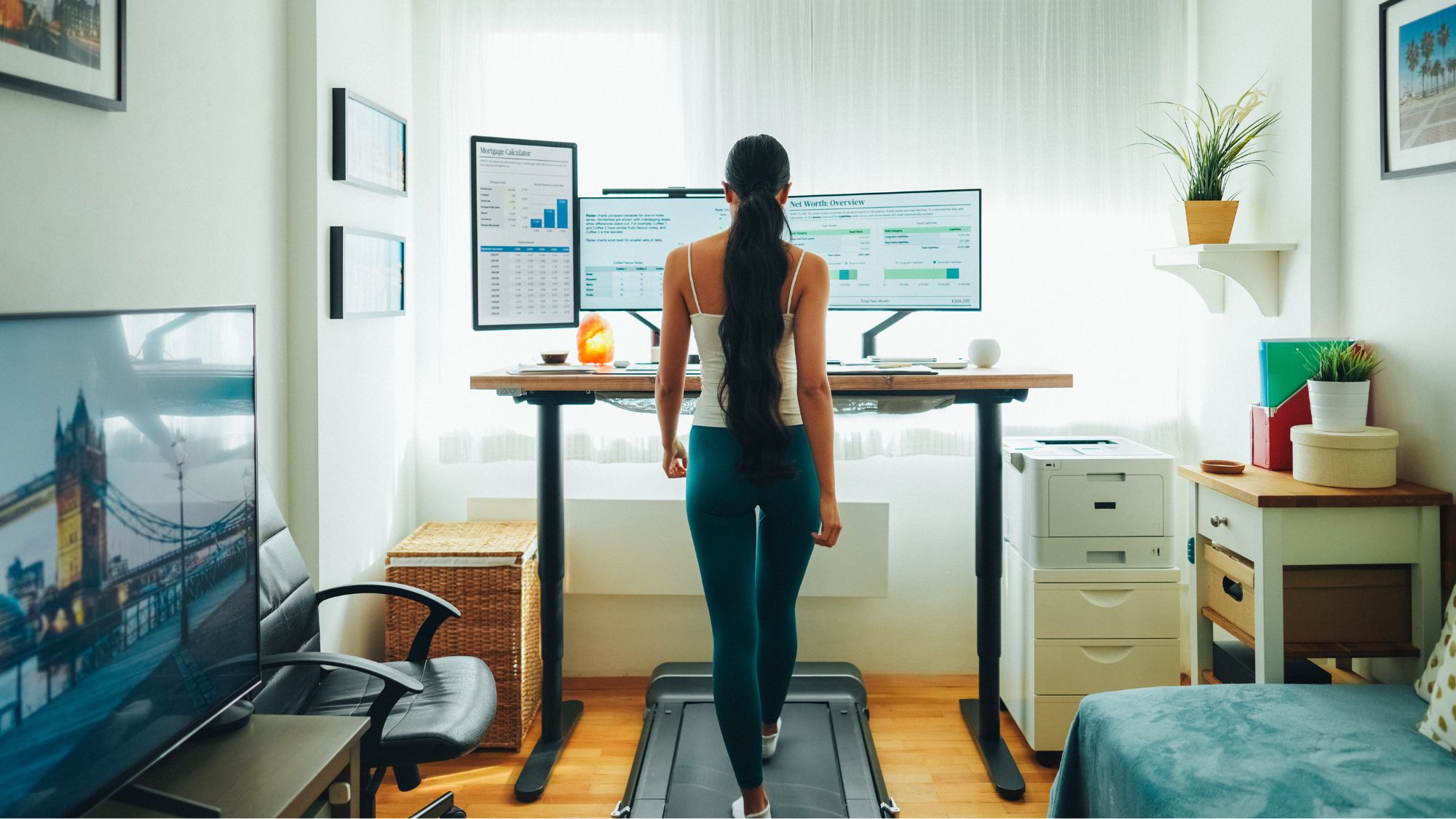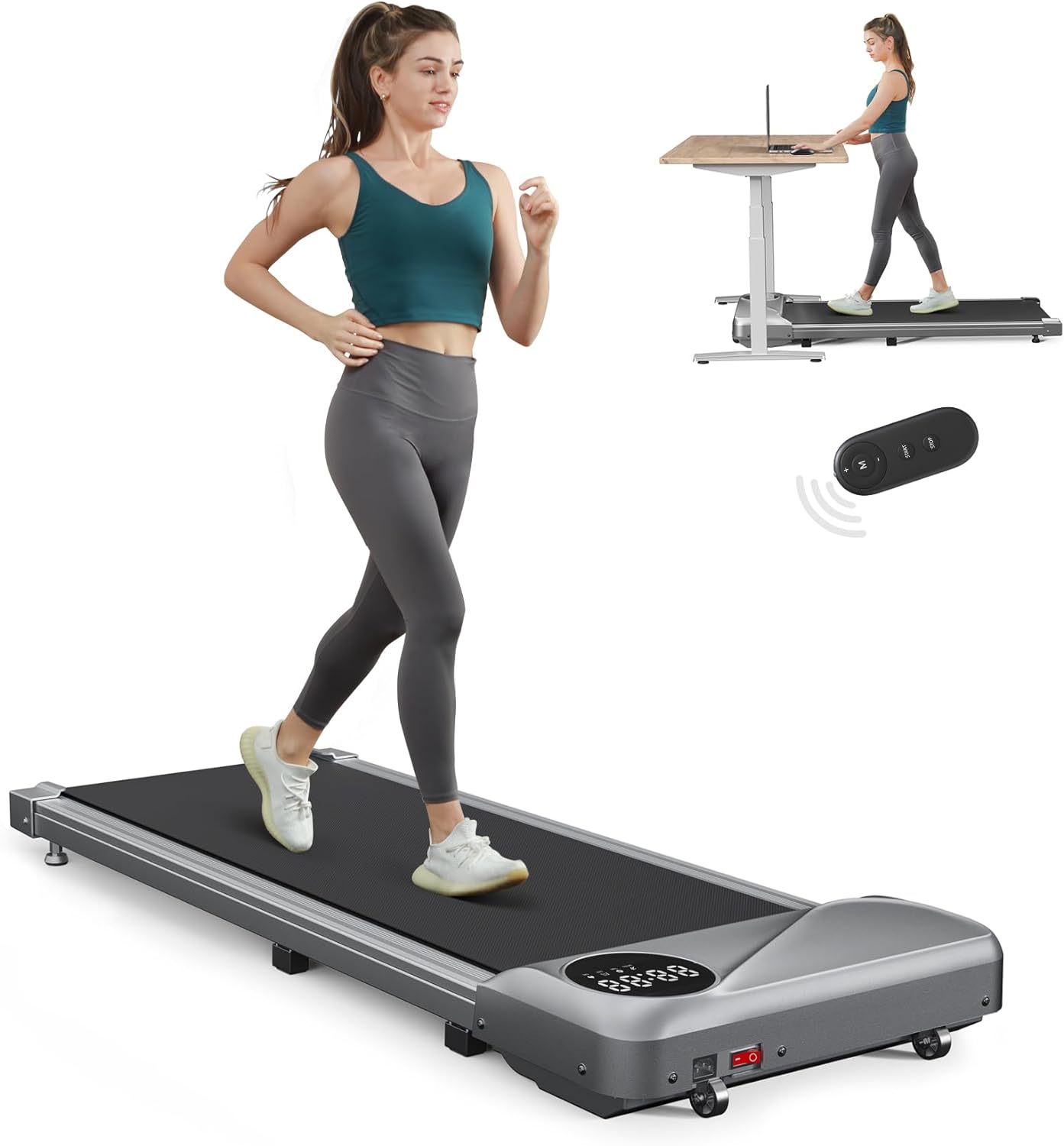Walking desks have exploded in popularity this year – 5 ways they promise to improve your life
Your need to knows.


I remember rolling my eyes when I first received a press release detailing the many walking desk benefits. What next, I thought. Dining chairs with pedals so we can cycle our way through mealtimes? A leg press toilet attachment so we can strength train while we… use the loo?
It’s not that I disagreed with the sentiment that we should be moving our bodies more – particularly when so many of us live such sedentary, desk-heavy lifestyles. NHS guidelines recommend at least two strength training sessions and 150 minutes of moderate-intensity activity or 75 minutes of vigorous-intensity activity a week to reduce the risk of developing some life-threatening conditions but, according to research by PureGym, 55% of the UK population doesn’t exercise at all. It’s clear that some kind of intervention, to help us increase our daily activity, is urgently needed – I just couldn’t see walking desks being that thing.
What sparked my spikiness was the feeling that walking desks were doubling down on toxic productivity and hustle culture. No time to workout? No problem – just do it while you work your day job. I was (still am) a perpetually stressed person spinning a lot of plates, as most of us are, and it felt like a gimmick designed to guilt me into multi-tasking my way to some fictitious version of myself who somehow seamlessly juggles it all. Basically, I wasn’t a fan. That was until last summer, when some colleagues and I competed in a month-long walking challenge.
The goal was simple: the person who wracks up the most steps wins. I had accepted early on that I was extremely unlikely to earn the top spot, given that some of my competitors walked 18,000-odd steps a day without batting an eye, but I thought I had a reasonable chance at placing somewhere among the top eight or so. However, one week in and I was already struggling to keep up. Although I’d easily clock a few thousand with a daily walk and some kitchen dancing while waiting for kettles to boil, I’d watch others’ step counts shoot up in the afternoons and by the time I finished work, they were way ahead of me. Some were dog parents who prioritised time outside prior to the competition for the wellbeing of their pooch, others were human parents juggling school runs and various clubs. Some were runners, who laced up during lunch breaks to get a few miles under their belts, others owned walking desks, and they’d wrack up steps while attending virtual meetings and replying to emails.
Suddenly, a walking pad didn’t feel like such a silly concept anymore, especially after I'd read Health Editor Ally Head's walking pad review. When I reshuffled my thoughts, they appeared to be quite helpful, actually – and not just for taking part in walking competitions. I considered the times I could barely leave my desk all day for meetings and deadlines, and the days I desperately wanted to head out for a walk but heavy rain put me off, and realised that my lifestyle probably isn’t undergoing an overhaul anytime soon. I need to be at a desk to do my job, regardless. A walking desk would at least give me the option to move as and when I want to throughout the day, without weather and meetings interfering. So, I gave it a go.
In short, I’m a convert. While I don’t think it’s necessarily a piece of kit for everyone, I do think there are many benefits to be had by using a walking desk, if it suits your lifestyle. What I loved, was that having an at-home treadmill (the Body Power Walking Pad) allowed me to get my steps in at any time of day when, in winter, I avoid being alone outside in the dark as much as possible. What surprised me was how having this equipment relieved some of the pressure I felt to move my body every day. Instead of clock-watching and checking the weather on busy workdays, trying to perfectly time my trip outside, I felt relieved that if it didn’t work out, I could walk while clearing my inbox or watching The Traitors, instead.
I want to be clear that a walking desk isn’t a replacement for walks outside in the fresh air, which offers myriad additional benefits, including improvements to mental wellbeing. I, instead, see it as a supplement. In the same way my prescribed iron tablets plug the gaps I haven’t been able to fill with diet alone, helping me meet my health needs, a walking desk allows me to top up my activity levels when I’m otherwise unable through work commitments, and such. It’s not a must-buy, it’s a nice-to-have for desk workers with busy schedules.
Celebrity news, beauty, fashion advice, and fascinating features, delivered straight to your inbox!
Positively swayed, I sought the advice of an expert to really learn about walking desk benefits. Here’s what they had to say.
The walking desk benefits are myriad - your guide
What is a walking desk?
“Walking desks are like the rock stars of office furniture,” says Gina John, osteopath and workplace assessor at Nordic Balance. Essentially, it’s a combination of a standing (or adjustable) desk and a walking pad or treadmill that allows you to walk while working at your desk.
“Picture this: you're strolling along at a slow pace, typing away or having that important Zoom call, all while keeping those legs moving,” John says. “Just watch out for spilled coffee, and you're on your way to a healthier, more productive workday.”
I know I said that the emphasis on productivity gives me the ick, but I will concede that it does feel nice to occasionally condense the time I have commitments throughout the day by getting my steps in while working through some of my easier tasks, even if I’d prefer a coastal walk sans work.
How do walking desks work?
It’s simple, really. In the same way that you might prop your phone on the little treadmill shelf at the gym so you can watch a series episode while walking, you just tweak your standing desk set-up to allow for a compact walking pad.
Walking desks are designed specifically for walking, not running, which means they’re much less bulky than the treadmills you’re used to seeing in a gym, and are easy to store (many fold in half, even). You just choose your speed, and you’re well on your way.
What is the average cost of a walking desk?
You can shop walking pads online from around the £200 mark, though some designs cost upwards of £1,000. Factor in that you’ll also need a standing or adjustable desk in order to be able to use the walking pad while you work, which will elevate costs by another couple hundred pounds, at least. Like I said, it’s not a must-have, it’s a luxury purchase.
Is it better to stand or walk at a desk?
“Whether a walking desk trumps sitting or standing at a desk really depends on what suits you best,” says John. “Standing at a desk can help you dodge the back pain that comes with sitting for ages and might keep you more alert,” she adds, with the caveat that too much standing can give you tired feet and legs.
Using a walking desk is ideal for busy days when you’re unlikely to meet your activity requirements, but it’s probably not suitable for tasks that need laser focus. Sitting, on the other hand, can be helpful for focus levels. Your best option, if you have the luxury of choosing, is to mix things up every once in a while.
“In the end, what works best is all about your work style, how your body feels, and what floats your boat,” says John. “Some folks like to switch things up during the day with a mix of all three. The key is to keep moving and change things around to stay healthy and on the ball.”
Can you be productive with a walking desk?
If anecdotal evidence alone is enough to go on, it would seem that many people find walking desks beneficial for productivity levels – including MC UK'S Senior Health Editor Ally Head.
“I was pleasantly surprised at how easy it was to work and walk - I'd thought that it might have been a pipe dream to think I could multi-task, but it was doable if I made sure my walking speed wasn't too fast,” she said after giving the walking desk trend a go for herself. “This was one learning - ramp the speed up and you'll likely want to get off quicker. Opt for a slower, steadier pace and you'll be able to walk for longer. I sometimes walked for up to 45 minutes to an hour a day.”
While there’s not yet much science on the benefits of using a walking desk, specifically, there is research that suggests it could have a positive impact on your work. A 2018 study by the University of Leicester published in the British Medical Journal found that having the option of a standing desk has a positive impact on work-related outcomes, such as job performance, work engagement and occupational fatigue. They also found it to be beneficial for anxiety and overall quality of life. Impressive.
Walking desk benefits: 5 ways using one could improve your life
1. It boosts your health
“Walking while working can improve your posture, and reduce the risks associated with sitting for long hours, like back pain and heart problems,” says John.
Walking is also great for increasing energy, improving sleep quality, lowering blood pressure and reducing stress and risk of developing conditions such as heart disease, stroke, asthma, type 2 diabetes, and some types of cancer.
2. It promises to boost energy boost
“Some people find that the gentle movement keeps them more alert and focused, so it's like a natural pick-me-up during the workday,” says John. I, personally, like a little afternoon movement to refresh my brain before I tackle the final few hours of the working day.
3. It'll boost fitness
As per the NHS website, ten minutes of daily walking can help to build stamina and improve your heart health and cardiovascular fitness. “With a walking desk, you also get to work your legs, glutes and core, all while sending emails. Talk about multi-tasking,” says John.
4. It could boost productivity
“Believe it or not, many people say they get more stuff done on a walking desk,” John says. “It might be because they're more engaged and less likely to get distracted.”
While I, personally, don’t consider productivity the be-all and end-all, I do concede that using a walking desk while working helped to boost my motivation to tick things off my to-do list, sometimes.
5. It'll boost creativity boost
“Sometimes, a change in scenery (even if it's just the view from your treadmill) can spark new ideas and creativity,” says John. It’s a good point. Ever notice how a short break from your desk to refill your coffee, for instance, feels like a mini mental refresh? The same could, in theory, be experienced by switching up your workspace with a walking desk.
What should I be aware of when using a walking desk?
There are a few things to be aware of when using a walking desk. “They can be safe when used correctly, but there are some potential risks to keep in mind,” says John. “You'll want to be cautious of tripping hazards by starting at a slow pace and ensuring the area around the desk is clear.” Prolonged use at high speeds can lead to muscle fatigue, she says, so taking regular breaks is crucial.
“Improper posture due to an incorrectly set up desk can also cause discomfort, so make sure your workstation is ergonomically sound.” Additionally, it’s important to pay attention to what your feet are doing while using a walking desk. Accidents happen, John says, when you get distracted. “Lastly, if you have any underlying health issues, it's wise to consult a healthcare professional before using a walking desk to ensure it's a safe option for you,” she advises.
Shop walking desks now
Are walking desks beneficial?
We all know walking is good for us, offering a low impact, easy way to maintain your fitness day to day. Walking desks are an easy way to up your step count from home, making movement less daunting and more appealing when it's baltic outside.
Not only do walking desks promise to boost your posture, they're great for increasing energy, improving sleep quality, lowering blood pressure and reducing stress, too. They also promise to lower your risk of developing conditions such as heart disease, stroke, asthma, type 2 diabetes, and some types of cancer.

Abbi Henderson is a freelance journalist and social media editor who covers health, fitness, women’s sport and lifestyle for titles including Women's Health and Stylist, among others.
With a desire to help make healthcare, exercise and sport more accessible to women, she writes about everything from the realities of seeking medical support as a woman to those of being a female athlete fighting for equality.
When she’s not working, she’s drinking tea, going on seaside walks, lifting weights, watching football, and probably cooking something pasta-based.


